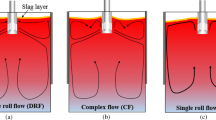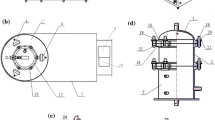Abstract
Monitoring the meniscus velocities of molten steel in continuous casting molds is critical for revealing the velocity field in the whole mold and consequently for process control and final product quality, however, the realization of contactless online measurement in an actual metallurgy environment is a highly challenging task. In this paper, we develop a special Lorentz force velocimetry (LFV) device to measure the local meniscus velocities of molten steel flow, and this device can adapt to harsh environments with high temperature, opaque liquid metal and surrounding complex electromagnetic noise. A series of laboratory experiments and calibrations were conducted to provide support for a follow-up in-plant test. The LFV device exhibits capability and feasibility for measuring the meniscus velocity in continuous casting molds during plant tests. On this basis, the velocity field and turbulent flow in a wide slab continuous casting mold are analyzed. The measured meniscus velocity is on the order of ~ 10−1 m/s, which is consistent with the results obtained via the nail-board approach.











Similar content being viewed by others
Notes
LSB-100 g is a registered trademark of Futek Company. This sensor can function in the environment of − 50 °C to 93 °C, and its data acquisition component is developed by Dewesoft Company, Slovenia.
DL-1 is a registered trademark of Beijing Yong Guangming Medical Instrument Co., Ltd.; power: 2 kW, size of furnace plate: 155 mm × 155 mm × 1 mm.
References
https://www.worldsteel.org/steel-by-topic/statistics/steel-statistical-yearbook-.html. Accessed 2017.
D. Jian: Ilmenau University of Technology, Ilmenau, 2012.
P. S. Srinivas, A. Singh, J. M. Korath and A. K. Jana, ISIJ International 2017, vol. 57, pp. 1553-1562.
R. M. McDavid and B. G. Thomas, Metall Mater Trans B 1996, vol. 27, pp. 672-685.
B. G. Thomas, Metall Mater Trans B 2002, vol. 33, pp. 795-812.
B. G. Thomas, Steel Res. Int. 2018, vol. 89, art. no. 1700312.
J. Sengupta, H. J. Shin, B. G. Thomas and S. H. Kim, Acta Materialia 2006, vol. 54, pp. 1165-1173.
T. Watanabe and M. Iguchi, ISIJ International 2009, vol. 49, pp. 182-188.
L. Zhang, S. Yang, K. Cai, J. Li, X. Wan and B. G. Thomas, Metallurgical and Materials Transactions B 2007, vol. 38, pp. 63-83.
R. Liu, B. G. Thomas, J. Sengupta, S. D. Chung and M. Trinh, ISIJ International 2014, vol. 54, pp. 2314-2323.
L. Ren, Iron and Steel 2016, vol. 51, pp. 35-40.
L. Ren, L. Zhang and Q. Wang, Metall. Res. Technol. 2018, vol. 115, art. no. 102.
M. Iguchi and Y. Terauchi, ISIJ International 2002, vol. 42, pp. 939-943.
J. Kubota, NKK Technical Review 2001, vol. 85, pp. 1-9.
M. Iguchi, H. Kosaka, H. Mizukami, M. Kawamoto, A. Hayashi, Y. Terauchi, M. Hanao and H. Kawabata, Metall Mater Trans B 1999, vol. 30, pp. 53-59.
R. Liu, J. Sengupta, D. Crosbie, S. Chung, M. Trinh and B. G. Thomas, Sensors, Sampling, and Simulation for Process Control, Wiley, New York, 2011, pp. 51-58.
B. Rietow and B.G. Thomas: Proc. of AISTech 2008 Steelmaking Conf., Warrendale, PA, 2008.
K. Cukierski and B. G. Thomas, Metallurgical and Materials Transactions B 2007, vol. 39, pp. 94-107.
A. Wegfrass, C. Diethold, M. Werner, T. Fröhlich, B. Halbedel, F. Hilbrunner, C. Resagk and A. Thess, Applied Physics Letters 2012, vol. 100, art. no. 194103.
D. Hernández, J. Schleichert, C. Karcher, T. Fröhlich, T. Wondrak and K. Timmel, Meas Sci Technol 2016, vol. 27, art. no. 065302.
M. Ratajczak, D. Hernández, T. Richter, D. Otte, D. Buchenau, N. Krauter and T. Wondrak, IOP Conf. Ser. Mater. Sci. Eng. 2017, vol. 228, art. no. 012023.
J. A. Shercliff, Journal of Fluid Mechanics 1962, vol. 13, 513–518.
A. Thess, E. V. Votyakov and Y. Kolesnikov, Phys Rev Lett 2006, vol. 96, art. no. 164501.
A. Thess, E. Votyakov, B. Knaepen and O. Zikanov, New Journal of Physics 2007, vol. 9, art. no. 299.
A. Viré, B. Knaepen and A. Thess, Physics of Fluids 2010, vol. 22, art. no. 125101.
V. Minchenya, C. Karcher, Y. Kolesnikov and A. Thess, Flow Measurement and Instrumentation 2011, vol. 22, pp. 242-247.
X. Wang, R. Klein, Y. Kolesnikov and A. Thess, Materials Science Forum 2011, vol. 690, pp. 99-102.
X. Wang, Y. Kolesnikov and A. Thess, Meas Sci Technol 2012, vol. 23, art. no. 045005.
A. Wegfrass, C. Diethold, M. Werner, C. Resagk, T. Fröhlich, B. Halbedel and A. Thess, Meas Sci Technol 2012, vol. 23, art. no. 105307.
D. Jian and C. Karcher, Meas Sci Technol 2012, vol. 23, art. no. 074021.
R. Klein, C. Weidermann, X. Wang, M. Gramss, A. Alferenok, A. Thieme, Y. Kolesnikov, C. Karcher and A. Thess, Technisches Messen 2012, vol. 79, pp. 394-398.
N. Dubovikova, C. Resagk, C. Karcher and Y. Kolesnikov, Meas. Sci. Technol. 2016, vol. 27, art. no. 055102.
D. Hernandez, T. Boeck, C. Karcher and T. Wondrak, Magnetohydrodynamics 2017, vol. 53, pp. 233-243.
Y. Tan, R. Liu, S. Dai, X. Wang, M. Ni, J. Yang, N. Dubovikova, Y. Kolesnikov and C. Karcher, Nuclear Science and Techniques 2018, vol. 29, art. no. 80.
Y. Kolesnikov, C. Karcher and A. Thess, Metallurgical and Materials Transactions B 2011, vol. 42, pp. 441-450.
D. Jian, J. Iron Steel Res. 2012, vol. 19, pp. 509–13.
D. Hernandez, T. Boeck, C. Karcher and T. Wondrak, Meas Sci Technol 2018, vol. 29, art. no. 015301.
T. Zürner, T. Vogt, C. Resagk, S. Eckert and J. Schumacher, Experiments in Fluids 2017, vol. 59, art. no. 3.
C. Stelian, Flow Measurement and Instrumentation 2013, vol. 33, pp. 36-44.
X. Wang, M. Isac and R. I. L. Guthrie, ISIJ International 2009, vol. 49, pp. 975-984.
M. Suzuki, H. Mizukami, T. Kitagawa, K. Kawakami, S. Uchida and Y. Komatsu, ISIJ International 1991, vol. 31, pp. 254-261.
F. Felten, Y. Fautrelle, Y. Du Terrail and O. Metais, Applied Mathematical Modelling 2004, vol. 28, pp. 15-27.
X. Wang, Y. Fautrelle, J. Etay and R. Moreau, Metallurgical and Materials Transactions B 2008, vol. 40, pp. 82-90.
P. Andrzejewski, K. U. Kohler and W. Pluschkell, Steel Res 1992, vol. 63, pp. 242-246.
Acknowledgments
This work is supported by the project funding (YZ201567) of the Chinese Academy of Sciences, the National Natural Science Foundation of China (51574091), and the Institute Collaborative Innovation Fund (111800XX62). Our thanks are also given to the Baosteel Central Research Institute for their experimental venues and technical guidance.
Author information
Authors and Affiliations
Corresponding authors
Additional information
Publisher's Note
Springer Nature remains neutral with regard to jurisdictional claims in published maps and institutional affiliations.
Manuscript submitted May 20, 2019.
Appendix
Appendix
In the actual continuous casting process, a layer of protective slag with almost zero conductivity is covered above the molten steel and insulates it from the copper mold. Therefore, the distribution of induced eddy current in the liquid steel with flux insulation in the copper mold is similar to that in a copper plate moving in the air.
In our work, the length, width, and height of the copper plate were 500, 300, and 50 mm, and those of the magnet were, 50, 50, and 10 mm (in Table I). It should be noted that here the width of the copper plate matches the width of the in-plant mold. We calculate the induced electric density by numerical simulation, to analyze the distribution characteristics of induced current and Lorentz force at different locations between the magnet and copper plate, as shown in Figures A1 and A2.
In Figure A1, The Lorentz force is analyzed at different off-center ratios, which is the ratio of the deviation between the permanent magnet center and the copper plate center to the half width of the copper plate. Since the Lorentz force calculated by us is the integral force in the area influenced by the moving conductor, we can see that, the closer the permanent magnet is to the edge of the copper plate, the greater the deviation of the Lorentz force is (from 100 to 20.8 pct), that is to say, the greater the influence of the edge effect.
This phenomenon can be explained by the distribution of the induced current density, as shown in Figure A2: From (a) and (b), as the position of permanent magnet changes, the distribution of the eddy current in copper plate changes correspondingly, but the Lorentz force hardly changes (Figure A1) because the eddy current distribution is limited by the geometry of the moving conductor, while the main area contributing to the Lorentz force is directly below the permanent magnet. However, if the permanent magnet is too close to the edge of the copper plate, the Lorentz force will not directly reflect the speed of the moving conductor due to the intensification of the edge effect of electromagnetic induction (Figures A2(c) and (d)). However, the edge effect of electromagnetic induction can be significant if the permanent magnet is too close to the edge of the copper plate (Figures A2(c) and (d)), which should be addressed if the flow speed close to the edge is to be measured.
In our work, the calibration is performed by placing the device above the center of the copper plate, and the in-plant test is performed with the device in the corresponding position.
Rights and permissions
About this article
Cite this article
Zheng, J., Liu, R., Wang, X. et al. An Online Contactless Investigation of the Meniscus Velocity in a Continuous Casting Mold Using Lorentz Force Velocimetry. Metall Mater Trans B 51, 558–569 (2020). https://doi.org/10.1007/s11663-019-01757-z
Received:
Published:
Issue Date:
DOI: https://doi.org/10.1007/s11663-019-01757-z






